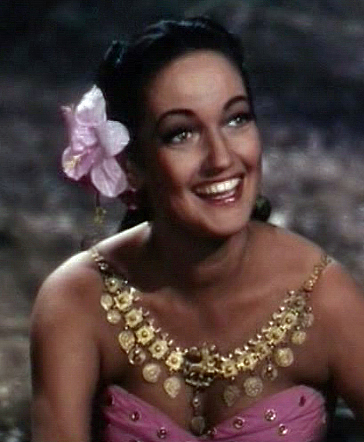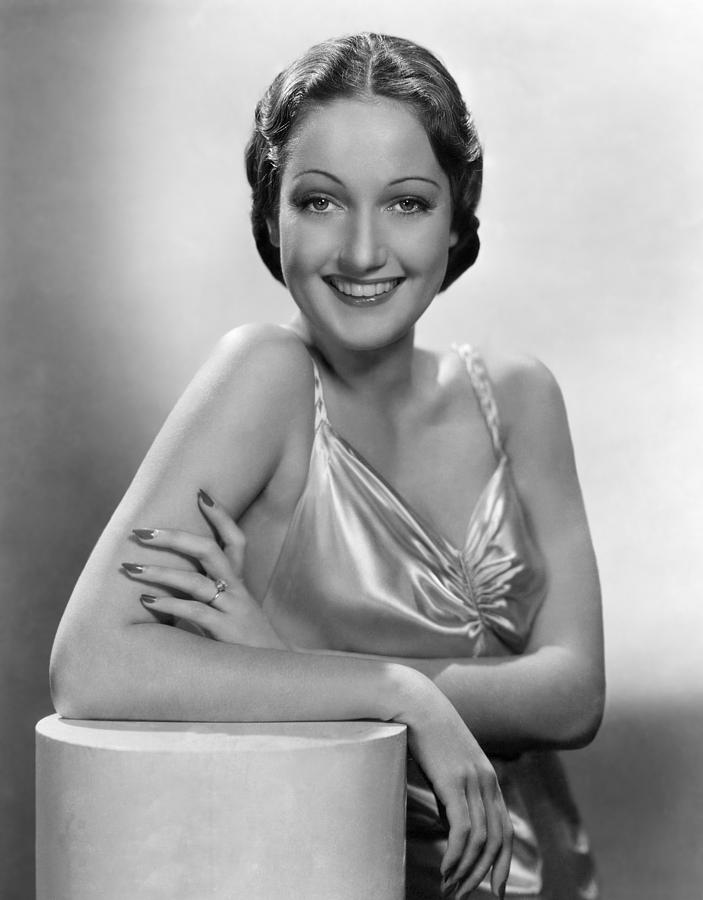 |
| Road to Bali c.1952 |
She was born Mary Leta Slaton December 10, 1914 in New Orleans, Louisiana. Her parents' marriage, like many marriages in those days, was one made in haste. They were divorced in only a few years, with Dorothy having little contact with her father for the rest of her life. Ms. Slaton later had her daughter take on the name of her step-father, Lambour. Once entering Hollywood, Dorothy would change this name from 'Lambour' to 'Lamour'.
A great beauty, Dorothy won the Miss New Orleans pageant at the age of eighteen, and used her earnings to take professional photographs and try her hand at acting in Hollywood. It was a rough road. When she first came to Hollywood in the early 1930s, the epitome of beauty was paved by platinum blondes. She was turned away many times, as 'most studios thought she was too unusual-looking'.
New Orleans was a safe-haven for racially ambiguous persons, and had been since before the Civil War. Within the city, there was an entire social class recognized as gens de couleur, which made it possible for non-white people of color to make a respectable living, learn a trade, and marry well in a time when slavery was still widely accepted. Lamour's mixed heritage, completely commonplace in her home city, was not entirely well-received outside of it.
 |
| Paramount Pictures Promotional Photograph |
While the ethnic diversity of 'Creole' is not necessarily inclusive of African-Islander, there was an underlining question about her heritage that would ultimately define her time on the silver screen.
Was she or wasn't she?
Lamour, for her part, never spoke of her ancestry openly.
Hollywood long had a history of 'white washing' racially ambiguous women who were considered star-material. From women who simply appeared, like Myrna Loy, to women who were actually of exotic lineage, like Merle Oberon, Hollywood went to great lengths to manipulate (or even exploit) the exteriors of these women in order to sell their image. It was no different for Dorothy. And so, Dorothy Lamour found her biggest, and brightest opportunities in Hollywood were to be playing natives, exotic women, and 'the girl in the sarong'.
 |
| c. 1937 |
After Paramount, Dorothy found a very welcoming audience in the nightclub and dinner theatre circuit. Gifted with a beautiful voice, she sang with an orchestra and did a few dance acts well into her sixties.
In her private life, Dorothy had married twice, and had given birth to two sons with her second husband.
In one of her last on-screen appearances at seventy-two, when asked if she were going to wear a sarong in her scenes, she quipped "Do you expect me to stand against a palm tree, and sing in the moonlight?"
Lamour passed away September 22, 1996, at her home in Los Angeles, California.
As a kid, I always suspected she was Creole, but she kept if well hidden. Too bad Lena Horne, Freddie Washimton and Dorothy Dandridge couldn't get a foothold in the industry because they wouldn't play their game like L'Amour chose to do.
ReplyDeleteAmen she passed for white. It took and still takes courage to be black in amerikkka.
DeleteInteresting how "Hollywood",then and now attempt to promote the myth of Eurocentric female beauty, yet spend thousands of dollars to have African look alike facial augmentation
DeleteVery sad to not be proud of your heritage.
ReplyDeleteEven sadder the society in which one lives would so denigrate a heritage that one would choose with alacrity not to be associated with that particular heritage if at all possible. Ever read Shakespeare’s play “Titus Andronicus”? The question was asked: “is Black so base a hue”?
DeleteThe color black is actually neutral. It’s what’s in the mind of him or her who assign whatever they choose to the color as in othe situations or distinctions. Yes, sad indeed.
It only now dawned on me to goggle Dorthy Lamour’s heritage. In the film “Manhandled” I surmised she had a certain aspect about her complexion that suggested she might be African American and thus had opted to pass a Caucasian. Hmmm. ����♂️
ReplyDeleteJust seen her in black n white film.
ReplyDeleteNever knew her. But realised she had Africa in the eyes.
It's interesting that someone mentioned Freddie Washington, Lena Horne and less so Dorothy Dandridge, who were very similar but we're considered black. Maybe she fooled white people, but my mother always said she was black or at least creole. Lots of people passed at work but came back to the black community at night, prior to desegregation of neighborhoods. I had a French teacher in HS, an NO creole, same thing. Passing isn't always a win of commission, often you leave it up to other people to assume and for white people the assumption is that someone is white. JE Hoover was the same thing as her, some black ancestry.
ReplyDeleteI meant sin of ...
ReplyDeleteHer sons would be the only ones to know for sure. I mean Catherine zeta Jones is Welsh.
ReplyDeleteDorothy was born in New Orleans, the word "Creole" is a code word meaning atleast one eight upto one third black. Yes, it was that "one drop" rule that made Mulatto's live in fear of being found out. God bless, and rest their souls....all they wanted was a chance to live the American dream.
ReplyDeleteThere will be a day of reckoning for our Country.
부산콜걸
ReplyDelete부산콜걸
철원콜걸
울산콜걸
대전콜걸
화천콜걸
광주콜걸
광주콜걸